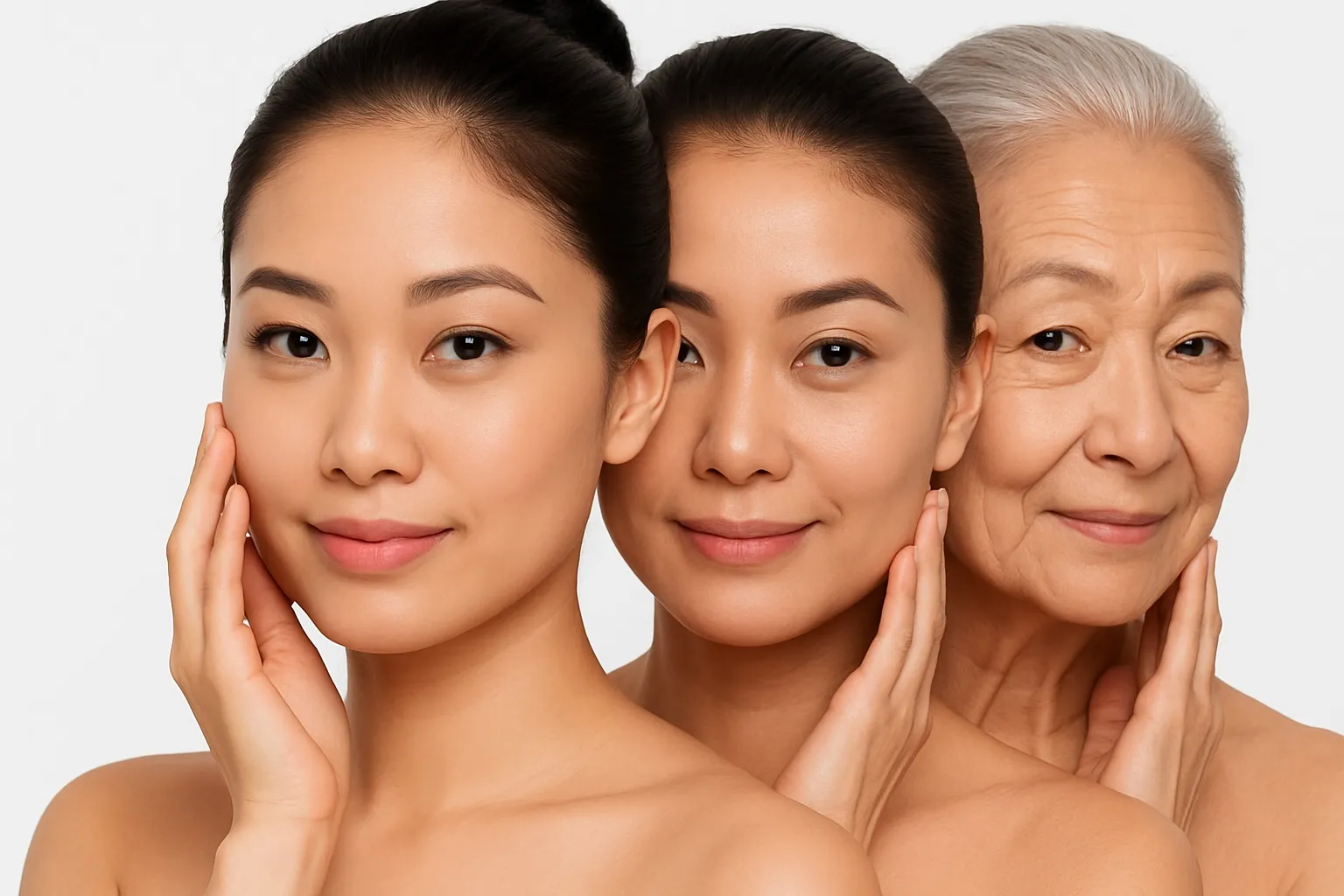August 23, 2025
Perimenopause and Your Skin
A Holistic Guide to Navigating Changes to your skin as you approach menopause.
The years leading up to menopause, known as perimenopause, often bring about rapid changes that can feel overwhelming. For many women in their 40s and 50s, usually the perimenopause age, this transition can seem to appear overnight—one day your skin is plump and firm, and the next you notice sagging, jowls, and a loss of facial definition.
These changes are driven primarily by fluctuating hormones, particularly declining estrogen, which influences everything from skin elasticity and thickness to moisture retention. While battling mood swings, irregular periods, and hot flashes is challenging enough, seeing a reflection you no longer recognize can deeply affect your self-esteem.
However, this transition is not all doom and gloom. With the right knowledge, approach, and attitude, you can take charge of your skin’s health, manage these changes effectively, and feel confident in your skin.
How Perimenopause Affects Your Skin
The hormonal shifts during perimenopause have several distinct effects on your skin's structure and appearance.
1. Reduced Collagen and Elasticity Estrogen is crucial for maintaining collagen, the protein that keeps skin firm, smooth, and plump. As estrogen levels drop, collagen production slows significantly. This leads to sagging skin, fine lines, wrinkles, and a general loss of facial volume. These changes can appear more pronounced under harsh lighting, such as the bright white fluorescent lights at a salon.
2. Increased Dryness and Enlarged Pores Lower estrogen levels also reduce the production of sebum (your skin's natural oil). This can lead to persistent dryness, even if you’ve had an oily complexion your entire life. Paradoxically, as the skin loses elasticity, pores can appear larger and more prominent.
3. Thinner, More Fragile Skin Your skin may become thinner and more fragile during this time, making it more prone to bruising, sensitivity, and irritation. This reduction in thickness also contributes to a loss of the youthful volume that defines facial contours.
4. Pigmentation and Uneven Tone Hormonal fluctuations can trigger an overproduction of melanin, leading to hyperpigmentation. This often appears as melasma (patches of discoloration) or age spots, particularly on the face and hands. Fortunately, these conditions can often be reversed and prevented with the right treatments and lifestyle adjustments.
5. Slower Healing and Cell Turnover With reduced cell turnover, your skin's natural repair processes slow down. Blemishes, cuts, or wounds may take longer to heal, and the post-inflammatory marks they leave behind can linger for much longer than they used to.
A Holistic Action Plan for Perimenopausal Skin
A comprehensive guide to maintaining healthy, resilient skin through lifestyle, skincare, and professional support.
Part 1: Lifestyle & Wellness Strategies
🍎 Nutrition for Skin Health
What you eat directly impacts your skin's ability to repair and regenerate. Focus on a diet rich in:
- Protein-Rich Foods: Fish, poultry, and legumes to support collagen repair.
- Vitamin C Sources: Berries, citrus fruits, and capsicums for collagen synthesis.
- Healthy Fats: Avocado, walnuts, and flaxseed to strengthen the skin’s barrier.
- Phytoestrogens: Soy, chickpeas, and flax to help support hormonal balance.
💧 Hydration
- Internal: Aim for 2-3 litres of water daily.
- External: Use a gentle, hydrating cleanser and a nourishing moisturiser.
💪 Exercise
- Strength Training: Maintains muscle tone and boosts metabolism.
- Yoga/Pilates: Supports posture and flexibility.
- Aerobic Activity: Boosts circulation for glowing skin.
😌 Stress Management
- Mindfulness: Meditation or journaling to lower cortisol.
- Support: Talk therapy can provide valuable coping tools.
🌙 Sleep
- Duration: Aim for 7–9 hours of quality sleep per night.
- Consistency: Maintain a regular bedtime for cell regeneration.
Part 2: Targeted Skincare Adjustments
Your skincare routine needs to adapt to your skin's new needs.
- ✨ Gentle Cleansers: Switch to mild, non-stripping cleansers to protect natural oils.
- 💧 Boost Hydration: Use ingredients like hyaluronic acid and ceramides.
- 🌟 Encourage Cell Turnover: Gradually introduce retinoids into your nighttime routine.
- ☀️ Protect Daily: Apply a broad-spectrum SPF every single day. This is non-negotiable.
Part 3: Professional Therapies
While home care is the foundation, professional treatments can offer more significant results.
- ⚡ Jet Plasma Regeneration: Stimulates collagen and elastin to improve firmness.
- 💦 Deep Hydration Facials: Replenishes lost moisture for plumper skin.
- 💡 LED Light Therapy: Soothes inflammation and supports skin healing.
- 💎 Gentle Resurfacing: Refines skin texture and brightens tone.
These therapies work best when integrated into a holistic plan that includes healthy eating, stress management, and a consistent home care routine.
Embrace the Transition with Confidence
Perimenopause is a natural and inevitable life stage. The key is to learn to accept, embrace, and work through it with proactive interventions rather than letting it control you.
By balancing nutrition, movement, stress management, and an effective skincare regime, you can empower yourself to keep your skin resilient, healthy, and radiant. Consistency is key: small, daily habits, combined with professional support when needed, will make a visible and lasting difference in how your skin looks and feels during this new chapter of life.
